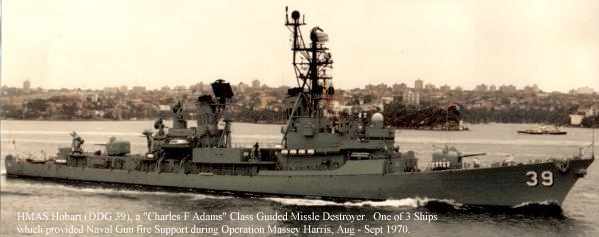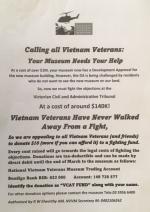
Specifications & History Of HMAS Hobart
The Vessel
The HMAS Hobart was a Charles F. Adams class guided missile destroyer in the Royal Australia Navy (DDG 39), built in the United States of America and commissioned in 1965 in Boston. Her role was air defence of the fleet.
Tours of duty
HMAS Hobart completed three tours of duty off Vietnam:
- 7th March 1967 - 27th September l967
- 22nd March 1968 -11th October 1968
- 6th March 1970 -17th October 1970
During her second deployment Hobart was under fire on three occasions. Also during her second deployment to Vietnam, Hobart was attacked by US aircraft and hit by "friendly fire"; two sailors lost their lives and seven others were injured. The deployment was mainly involved in NGFS (Naval Gun Fire Support) in support of a joint Australian/ARVN sweep between the Long Hai hills and the coastline.
In 1988 HMAS Hobart participated in the Hobart Bicentennial Australia Day Celebrations.
Class of ship
An improved Charles F. Adams class guided missile destroyer whose main role was air defence of the Fleet. The design of ships of this class was particularly versatile and she had anti-submarine and surface gunnery capabilities.
Dimensions
Length 7 feet (133.2 metres)
Beam (width) 47 feet (14.3 metres)
Displacement 4,720 tonnes
Complement 20 Officers and 312 Sailors
Design and building
Keel laid 26 October 1962.
Launched 9 January 1964 by Mrs David Hay, wife of the then Australian Ambassador to the United Nations.
Commissioned December 18, 1965 at Boston.
Built by Defoe Shipbuilding Co., Bay City, Michigan - the second of three guided missile destroyers built for the Royal Australian Navy.
Armament
TARTAR guided missile (single rail launcher), two 5"/54 calibre rapid fire fully automatic guns (in single turrets). Anti-submarine torpedoes (two triple mounts). IKARA, Australian designed and built long-range anti-submarine weapon (fitted in Australia).
Propulsion
Speeds in excess of 30 knots were obtained from geared steam turbines on two shafts.
Command facilities
The latest concepts in long range sonar, radar, communication and electronic equipment provided the Command with the necessary up-to-date information in the Operations Room.
Accommodation
All living spaces were air-conditioned. Amenities included regular movie shows, internal news and broadcasting services, free laundry, a canteen stocked with a wide variety of goods and all the latest facilities expected of modern day ships.
Cost
Purchased by Australia from the United States of America for US$45,000,000 including spare parts, stores, ammunition etc.


